Open, which was conducted using advanced knowledge and experience in the field of theoretical molecular chemistry has allowed the practice to start production of a series of polymeric materials based on the polymerization reaction (polycondensation). These include, for example, polyethylene, polypropylene and polyvinyl acetate, which differ in:
- Elasticity and resilience.
- Durability and abrasion resistance.
- Component (coagulant) to clean wastewater and sewage by chemical reaction.
- Dispersant to reduce the viscosity in the working solutions of dispersed systems, water-based.
- Fertilizers to retain moisture in the soil.
- medicine to close wounds and burns.
- Tools hyena in the manufacture of diapers and pads.
Another part with the prefix "poly" in its chemical formula of a group of molecules able to react (ionize) in aqueous solution. Polyelectrolytes (the official name of the polymer) is also widespread as:
the Polyelectrolytes, according to the http://dominant102.ru/polielektrolity, proven themselves as additives to lubrication system components and assemblies. Their ability to form electric double-molecular layer on the surface of the parts can significantly reduce the occur destructive force of friction.
Practical application of polyelectrolytes
the Greatest interest among scientists and researchers caused the presence of polyelectrolytes the properties of their localization in an aqueous solution with the formation (swelling) kind of the helium composition. This allowed the use of a substance as:
Recent studies have shown that in certain proportions and conditions, a porous gel-based polyelectrolyte may, as a sorbent to retain heavy metals even in flowing water.
to Get more information about the polyelectrolytes used as components in various areas of production, sanitation and environmental activities by using the company website, supplying and implementation in an online format upon request of the buyer.





